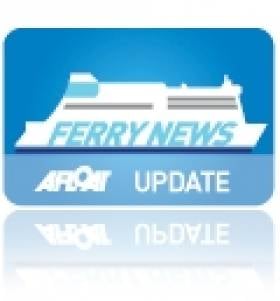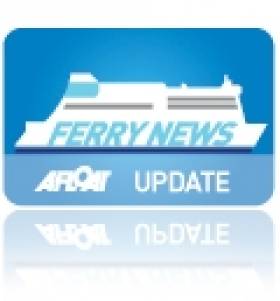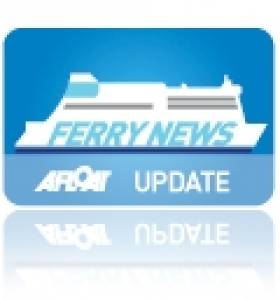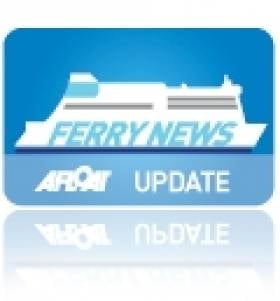Displaying items by tag: FGS Flensburg
Precision Timing as Freight Newbuild Completes Quartet
#FINAL FREIGHT-FERRY – Seatruck Precision has become the final newbuild of a quartet of ro-ro freight-only ferries to enter Irish Sea service for Seatruck Ferries, writes Jehan Ashmore.
The 18,920 tonnes newbuild completed her maiden 'commercial' round-trip, departing Liverpool on Tuesday and returning overnight from Dublin with an arrival on Merseyside early yesterday morning.
She was built by Flensburger Schiffbau-Gesellschaft (FGS), Germany along with her sisters with each having a freight capacity of 2,166 lane metres spread over four decks, carrying 151 (un-accompanied) trailer units. An increase of 36 trailers compared to the quartet of older 'P' class ships.
The FGS quartet are called the 'Heyham'-max series, as they are the largest-ever vessels designed to use the tight confines of the Lancashire port. It is believed that the latest newbuild will be deployed out of the port joining Seatruck Performance, the third newbuild of the series which runs on the route to Dublin.
The remaining pair, Seatruck Power and leadship of the series Seatruck Progress operate on the Dublin-Liverpool route. However as the latter vessel is currently moored at Cammell Laird shiprepair facility in Birkenhead, the newbuild is deputising in her place on the central corridor route.
Seatruck also operate Heysham-Warrenpoint and in May a new route Heysham-Belfast began service.
Another Fine Performance
#SEATRUCK NEWBUILD - With the announcement of Seatruck Ferries new Belfast-Heysham route to open in May, the company have in the meantime introduced a newbuild this week on the Dublin-Heysham route, writes Jehan Ashmore.
Seatruck Performance brings additional capacity to the route to Lancashire and becomes the third newbuild to enter the Irish Sea where her sisters are operating Dublin-Liverpool sailings.
She has a length of 142 m, breadth of 25 m and a capacity of 151 units, which is 35 more than the earlier 'P' Class ships which have shifted elsewhere on the Seatruck network.
The final fourth vessel Seatruck Precision as previously reported is currently under construction at the FGS Flensburg yard in Germany and is expected to make her debut on the Irish Sea in June.
- Seatruck Ferries
- Seatruck Performance
- Seatruck Precision
- Irish Sea freightferry market
- Irish Sea freight haulage market
- Irish Sea roadhaulage sector
- Ports and Shipping News
- DubliLiverpool
- DublinHeysham
- BelfastHeysham
- FGS
- FGS Flensburg
- HeyshamMax newbuilds
- Pclass Seatruck newbuilds
- Port of Heysham
- New Irish Sea freightferry
Seatruck Newbuild Makes a Fleeting Appearance
#FERRY NEWS-Seatruck Progress (5,300 dwt) the new freight-only ro-ro, due to enter Seatruck Ferries Dublin-Liverpool service this month, as previously reported on Afloat.ie, sailed past Dublin Bay on Tuesday. She continued her overnight delivery voyage to arrive in Liverpool yesterday, fresh from German builders, FGS Flensburg, writes Jehan Ashmore.
As the newbuild approached Dublin Bay, she set a course to the east of the Burford Bank buoys where she continued her voyage to Liverpool, entering the Bootle docks through Langton Lock.
The Douglas registered ro-ro is to be joined by her fleetmate, Seatruck Power on the central corridor service next February. Each of the 21-knot quartet measure 142m long, have a beam of 24m and cater for 2,166 lane freight-metres with the use of an added upper fourth deck.
The increased capacity will enable un-accompanied trailer units to reach 70 on each of the sailings, which are currently served by smaller 'P' series ro-ro's Clipper Point and Clipper Pennant. These vessels were also commissioned by Seatruck from Spanish shipyards and entered servvice several years ago.
Seatruck which is a subsidiary of the Danish-owned Clipper Group, is set to expand the fleet as the Irish Sea's only freight-only operator with a futher pair of the same class from FGS, which are due for delivery in the first-half of 2012. According to Seatruck, these newbuilds are likely to be deployed on the company's other Irish Sea routes.
Seatruck's New Freight-Ferry on Delivery Voyage
#FERRY NEWS-Seatruck Progress (photo), the first of two 18,900 gross tonnes ro-ro newbuilds due to enter on Seatruck Ferries Dublin-Liverpool route, is en -route in the English Channel today from German builders, FGS Flensburg, writes Jehan Ashmore.
Her sister Seatruck Power is due to join her fleetmate on the central corridor service by mid-February. In addition Seatruck have on order another pair of the same class from FGS which are to be completed in 2012 and are likely to be deployed on the company's other Irish Sea routes.
The new quartet each measure 142m and will offer 2,166 lane freight-metres spread over four decks. They will each have a capacity of 150 units, 35 more than Seatruck's current P Series vessels in which Clipper Point and Clipper Pennant are currently employed on the route.
The company operate 80 sailings per week on four routes: Dublin-Liverpool,Dublin- Heysham, Warrenpoint-Heysham and Larne-Heysham. The newbuilds will also be the largest vessels ever to operate out of Heysham.
In the last two years freight volumes doubled and Seatruck has 20% of the Irish Sea market as against 3.7% in 2004. This year Seatruck will ship 300,000 units on the Irish Sea and with the fleet expansion this total will grow substantially in 2012.
Car-Sales Boost Brings Busy Day to Dublin
Normally the Pauline operates on other routes. She along with her sister Yasmine are the largest vessels in the Compagnie Luxemburgeoise de navigation SA (CLnd) / Cobelfret fleet. The vessels are of the Con-Ro design, also known as the 'HumberMax' vessels which have 5,632 lane metres capable of carrying 258 container trailers and 656 cars.
Apart from the Dublin debut of the Pauline which docked at Ocean Pier, the final vessel of the trio, Celestine (1996 / 23,986grt) was the first to arrive from Zeebrugge, docking at the ferryport berth 51A (also used daily by Stena Line vessels). Like the Pauline, the Opaline (2009 / 25,235grt) docked at Ocean Pier and is the newest and last of six newbuilds built from German yard of FGS Flensburg.
CLnD won the Short-Sea Shipping Company Award in 2010 at the Irish Exporter Awards in November and hosted by the Irish Exporter Association (IEA). The award was sponsored by the Irish Maritime Development Office (IMDO) which recognises the strategically important role of short sea shipping to our island economy.
There are four sailings operated by CLnD between Dublin Port and Rotterdam / Zeebrugge. From the Dutch port there are onward sailings linking Göteborg and Esbjerg while the Belgian route connects the UK ports of Killingholme, Purfleet and Ipswich.
The development of the Irish routes are part of the "Motorways of the Sea", an EU-wide programme to promote a modal shift of goods from congested roads to alternative sea transportation. In addition to the concept is the international trend in the use of larger and more efficient vessels.
In October 2009 CLnD /Cobelfret switched their Irish operations from Rosslare to Dublin Port. The transfer to Dublin allowed CLnD to introduce larger tonnage at the then newly upggraded No. 2 ro-ro linkspan at Ocean Pier, Alexandra Basin East.
CLdN ro-ro SA and CLdN ro-ro UK offer ro-ro connections from Belgium and the Netherlands to the UK, Ireland, Sweden and Denmark. Both divisions share a combined core fleet of 20 vessels. Some ships including the Pauline are registered and flagged from land-locked Luxembourg. The fleet operate on short sea ro-ro trade routes, occasionally supplemented by time chartered tonnage, which accommodate trailers, containers, vehicles and other rolling equipment.

































































